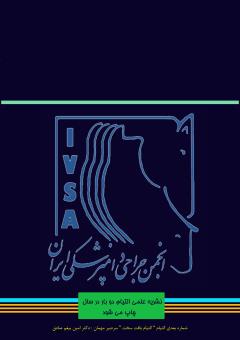Digit amputation in cattle
Subject Areas : Veterinary Soft and Hard Tissue Surgery
Sajjad Pishbin
1
,
Farzad Hayati
2
*
![]()
1 - Department of Clinical Science, Faculty of Veterinary Medicine, Ferdowsi University of Mashhad, Mashhad, Iran
2 - Department of Clinical Science, Faculty of Veterinary Medicine, Ferdowsi University of Mashhad, Mashhad, Iran
Keywords: Digit amputation, Cattle, Lameness,
Abstract :
Lameness of limbs is one of the most important problems of today's cattle farms, which causes irreparable economic losses, so that about 60% of cows in each herd are lame at least once a year (finger injuries in Iran are 31.8%). Injuries of the digits is one of the major causes of lameness in cattle. Bones of the digits in cattle include the first, second and, third phalanx. Two vestigial digits are existed in cattle. The medial digit and the lateral digit are the main weight bearing structures on the forelimb and hindlimb, respectively. One of the practical treatments for injuries of the digits is its amputation. Among the most important causes of digit amputation, can mention osteomyelitis of finger and navicular bones, septic arthritis of interdigital joints, fractures and hoof traumas that have not responded to other conservative treatment. Most of digit amputation procedures perform under local anesthetic techniques with the cattle standing position. Selection of digit amputation techniques depends on several factors, such as the lesion type and the extent of involved anatomical structures. The most common surgical method is to amputate the digit through the distal aspect of the proximal phalanx without the need for a skin flap, which usually has a good prognosis and is effective in improving the economic life of the animal. Todays, limb amputation and the use of prosthesis are indicated in cattle or calf with untreatable musculoskeletal trauma or infection. General anesthesia is recommended for limb amputation. Although the short-term prognosis for limb amputation is good, the long-term prognosis depends on the weight of the animal and caring condition.
1. Clark C, Petrie L. Fracture toughness of bovine claw horn from cattle with and without vertical fissures. The Veterinary Journal. 2007;173(3):541-7.
2. A. David Weaver OA, Guy St. Jean, Steiner. AA. Bovine Surgery and Lameness. 3 ed2018. 315-320.
3. Kofler J, Feist M, Starke A, Nuss K. Resection of the distal/proximal interphalangeal joint and digit amputation in 21 breeding bulls--indications, clinical findings and longterm outcome. Berliner und Munchener Tierarztliche Wochenschrift. 2007;120(3-4):156-64.
4. Kofler J. Clinical study of toe ulcer and necrosis of the apex of the distal phalanx in 53 cattle. The veterinary journal. 1999;157(2):139-47.
5. Simpson KM, Streeter RN, Jones ML, Taylor JD, Callan RJ, Holt TN. Review of digital anatomy, infectious causes of lameness, and regional intravenous perfusion in cattle. The Bovine Practitioner. 2020:17-29.
6. Nuss K. Surgery of the distal limb. Veterinary Clinics: Food Animal Practice. 2016;32(3):753-75.
7. Greenough P, Ferguson JG. Alternatives to amputation. Veterinary Clinics of North America: Food Animal Practice. 1985;1(1):195-203.
8. Desrochers A, Anderson DE, Jean GS. Surgical diseases and techniques of the digit. Veterinary Clinics of North America: Food Animal Practice. 2008;24(3):535-50.
9. Heppelmann M, Kofler J, Meyer H, Rehage J, Starke A. Advances in surgical treatment of septic arthritis of the distal interphalangeal joint in cattle: A review. The Veterinary Journal. 2009;182(2):162-75.
10. Desrochers A, St-Jean G, Anderson DE. Limb amputation and prosthesis. Veterinary Clinics: Food Animal Practice. 2014;30(1):143-55.

